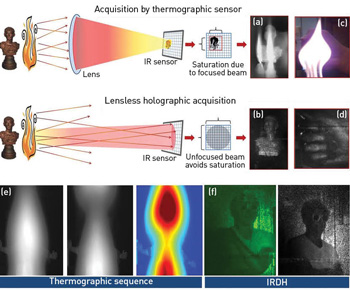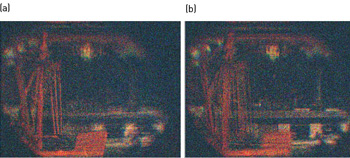 Schematic of the classical approach making use of IR bolometers, compared with lensless IRDH. (a) Thermographic image of a metal object through candle flame. (b) DH reconstruction of the object. (c) White light image of a man’s hand through stove flames. (d) Clear infrared radiation DH reconstruction of the hand through the flames. (e) Thermographic images of a man standing behind a flame. (f) DH reconstructions of live humans, clearly visible through flames generated in (e).
Schematic of the classical approach making use of IR bolometers, compared with lensless IRDH. (a) Thermographic image of a metal object through candle flame. (b) DH reconstruction of the object. (c) White light image of a man’s hand through stove flames. (d) Clear infrared radiation DH reconstruction of the hand through the flames. (e) Thermographic images of a man standing behind a flame. (f) DH reconstructions of live humans, clearly visible through flames generated in (e).
Lensless Digital Holography Improves Fire Safety
House fires cause thousands of deaths every year.1 Firefighters and first responders are called on to work in these hostile environments where their vision is impaired due to curtains of smoke and walls of flames. They can use thermographic cameras equipped with infrared radiation (IR) bolometers to see through the smoke because IR is only slightly scattered by smoke particles, allowing for a clear view of the scene. However, rescuers cannot use IR bolometers to detect a target hidden behind fire because their eyes are blinded by the flame’s emission. Radiation from the fire is conveyed onto some of the IR bolometer’s sensor detector elements, thus provoking their saturation. As a consequence, the useful signal cannot be discerned and gets lost.
IR digital holography (IRDH) could provide firefighters and first responders with a way to see through fire. IRDH allows the user to record holograms out of the focus plane with a lens-free setup and perform the numerical focusing afterwards.2,3 Thus, the flame-emitted radiation is scrambled over the whole sensor area, avoiding saturation. At the same time, the coherence of this holographic approach definitively helps the imaging process.3,4 The maximum size of the objects that can be imaged with IRDH is proportional to the source wavelength at any fixed target-sensor distance. Therefore, an IR laser source working at 10.6 µm can produce a holographic recording of a live human moving behind a flame.3 The adopted wavelength also makes the recording process much less sensitive to vibrations so that the IRDH device can be brought out of the laboratory and into the field.5 In the future, firefighters and first responders could use IRDH tools to get a clearer view of the scene and hopefully save more lives during their dangerous rescue operations.
M. Locatelli, E. Pugliese, M. Paturzo, V. Bianco, A. Finizio,
A. Pelagotti, P. Poggi, L. Miccio, R. Meucci and P. Ferraro
CNR—National Institute of Optics, Florence, Italy
References and Resources
-
U.S. Fire Administration
-
A. Pelagotti et al. J. Display Technol. 6, 465 (2010).
-
M. Locatelli et al. Opt. Exp. 21, 5379 (2013).
-
V. Bianco et al. Opt. Lett. 37, 4212 (2012).
-
J-F. Vandenrijt. Opt. Eng. 52, 101903 (2013).
> This summary contains a video component.
 Two frames from the movie show a close toy boat (a) and distant buildings (b) focused with the self-interference incoherent digital holography scheme.
Two frames from the movie show a close toy boat (a) and distant buildings (b) focused with the self-interference incoherent digital holography scheme.
Holographic Camera Uses Full-Color Natural Light
Holography has widespread influence in many areas of technology, from metrology and biomedical imaging to fine arts and entertainment. But holography’s coherent light requirement presents a serious constraint for a wider range of applications.1 With coherent laser illumination, holographic 3-D imaging would not be as easy and mundane as basic photography.
Many researchers have tried to record holograms under incoherent illumination, but most of their methods have limited degrees of practicality. However, a recent development called Fresnel incoherent correlation holography (FINCH) shows promise. FINCH is based on self-interference between two copies of a spherical wave from each source point, using a spatial light modulator as a combination of curved and flat mirrors.2 I proposed an incoherent holography scheme for adaptive optics called self-interference incoherent digital holography (SIDH). SIDH measures and compensates for aberrations using only holographic processes—removing the need for wavefront sensors or deformable mirrors.3,4 The technique is being developed for potential applications in astronomical and ophthalmic imaging.
SIDH is based on a modified Michelson interferometer with two mirrors of different curvatures and can be used to generate full-color 3-D images of naturally lit outdoor scenes.5 First, a color CCD camera acquires the interferograms. Next, the three color channels are separated and analyzed individually to obtain the red, green and blue component holograms. The resultant amplitude images are then combined to produce 3-D full-color holographic images of daylight-illuminated outdoor scenes. The 3-D content of the holographic image is demonstrated by numerically focusing to different distances. This may be the first recording of outdoor scenes under daylight illumination using a holographic process.
Incoherent digital holography techniques like SIDH open up a wide range of new applications and capabilities for holography because they remove the serious constraint of coherent lasers as illumination sources. One can expect applications in all areas of imaging such as astronomy, remote sensing and fluorescence imaging, as well as in non-optical wavelengths such as X-ray imaging.
Myung K. Kim
University of South Florida, Tampa, Fla., U.S.A.
References and Resources
-
M.K. Kim, Digital Holographic Microscopy: Principles, Techniques, and Applications, Springer (2011).
-
J. Rosen and G. Brooker.
“Non-scanning motionless fluorescence three-dimensional holographic microscopy,” Nat. Photonics 2, 190 (2008). -
M.K. Kim. “Adaptive optics by incoherent digital holography,” Opt. Lett. 37, 2694 (2012).
-
M.K. Kim. “Incoherent digital holographic adaptive optics,” Appl. Opt. 52, A117 (2013).
-
M.K. Kim. “Full color natural light holographic camera,” Opt. Express 21, 9636 (2013).
> This summary contains a video component.
